In fact, it's the opposite; most people treat contracts as poison. Little do they know the importance of understanding. If a loser doesn’t trade contracts, do they expect to get rich by hoarding coins?
Contracts are not scary; find the bottom to build positions. Before building positions, always calculate the stop-loss point you can bear. If you are right, hold on; if you are wrong, cut losses. Repeat this process, and making money is that simple.
Many people treat contracts as poison because they see contracts as tools of a casino. Remember, classmates, we are speculators, not gamblers.
There are many experts in contract trading. My suggestion for playing contracts is:
1) At a low point, take a shot, lay flat, and that’s it. Don't let the market wash you out; hold onto trend positions. If you want to earn, earn big; just chasing small gains is not useful.
2) Do not roll over positions or add to positions when opening. Before opening a position, you must anticipate all the worst-case scenarios and set a stop-loss. If you add a position later, it means you were wrong from the start; if you were wrong, why continue?
3) Freedom in going long or short is fine, but I still suggest you trade contracts with bullish bets. The upward potential is limitless; capturing a trend position can yield significant profits. To profit from shorting, you need to keep rolling positions in a trending market, but this can easily lead to liquidation from a rebound.
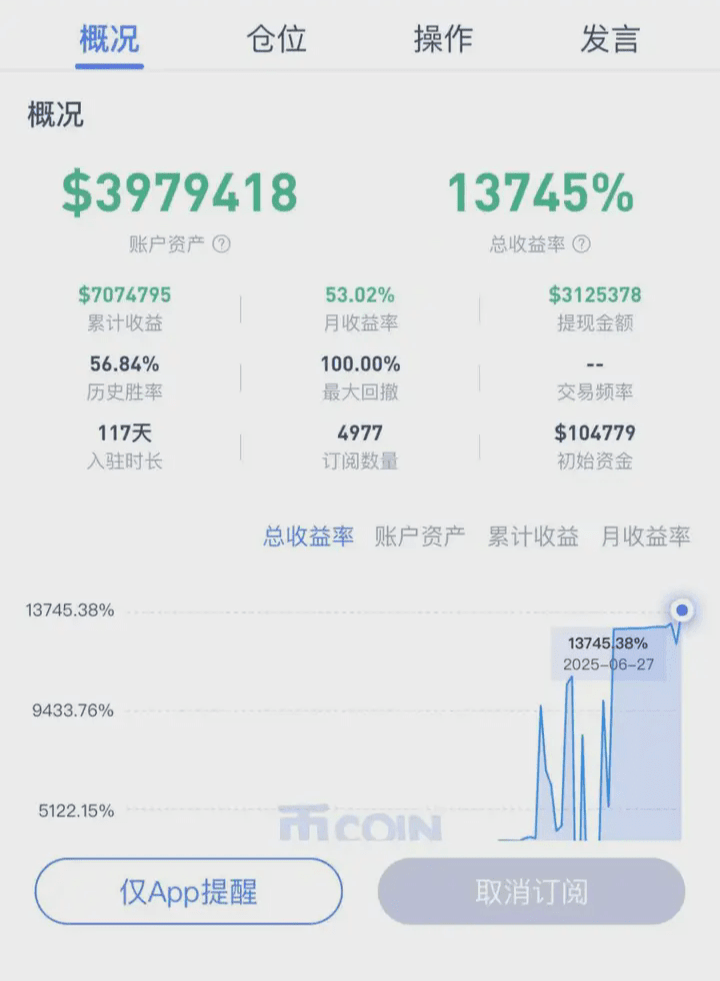
Now let’s talk about the seven deadly sins of contract trading.
1. Position syndrome: This is a common ailment among investors, characterized by symptoms such as: feeling restless when there are no positions and feeling the urge to place orders; being anxious when holding positions and unsure what to do if the market moves in the opposite direction; believing in continuous opportunities, leading to constant trading that results in increasing losses.
2. Frequent 'all-weather' trading: Many investors aspire to be versatile, going long and short alternately. Although they hold themselves to strict standards, this contradicts the importance of following the market trend. When there is no force breaking the opposing force, do not entertain contrary thoughts. In a bullish market, focus on going long, closing long positions, and going long again... In a bearish market, stick to shorting, closing shorts, and shorting again...
3. Counter-trend rebound grabbing: Can you grab rebounds? If the method is correct, of course, you can. Otherwise, it’s like licking blood on a knife’s edge. If a knife falls from the sky, when should you catch it? Undoubtedly, you should wait until it falls to the ground and stops moving. Otherwise, you will surely be injured. Grabbing rebounds requires skill; inexperienced traders should not take risks, but rather follow the trend.
4. Hesitating when placing orders: Fear of being lured into a long position when going long, or fear of being lured into a short position when going short, leads to missed opportunities. Understand the principle that there is always some inertia in starting a train; when the trend takes its first step, we should join in at one and a half steps until the balance is broken and the trend is established. When signs of a false breakout appear, the odds of winning in the opposite direction are significant.
5. The mindset of being watched by the main force: Many investors have had this experience: when you go long, the price falls; when you short, it rises; and if you cut your long position, it keeps rising; if you cut your short position, it falls. In BTC trading, luck is sometimes crucial, as the main force doesn’t care about your position. Close your computer immediately, take a break, and come back to trade calmly.
6. Full position trading: Full position trading can rapidly increase your wealth, but it can also lead to rapid liquidation. Nothing is absolute; even funds cannot fully control the impact of unexpected events, policies, or news. Never go full position; each opening should not exceed 30% of your total capital, at most 50%, to prevent the need to add positions or other situations.
7. Refusing to admit defeat: Many investors are stubborn; when they make a mistake, they never admit it, failing to resolve the wrong position promptly, leading to the continuation of errors with foreseeable consequences. 'I just don’t believe it won’t rise; I just don’t believe it won’t fall...' This mindset is utterly unacceptable. When you admit you are wrong, do not harbor any lucky thoughts; decisively cut losses at the first moment.
So how can we play contract trading correctly?
After more than 10 years of trading coins, the pain of five contract liquidations in the early years finally taught me the only secret to trading contracts!
First: How to get started with market charts.
Since we are trading contracts, we should know the most basic common sense.
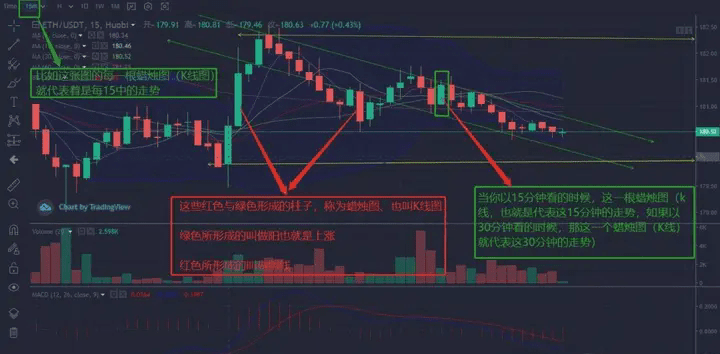
Since we are trading contracts, we cannot avoid market analysis charts. Friends who have been exposed to stocks, futures, and spot trading will surely be familiar with this, but beginners may feel a bit confused.
1. In the diagram, the columns formed by red and green are called candlestick charts, or K-line charts.
2. Each column represents the trend of each time period. For example, the current chart uses the 15-minute chart (circled in the upper left). Each column represents a 15-minute trend; for example, starting at 12:00, a candlestick forms at 12:15, and another at 12:30. When switching to a 30-minute chart, each candlestick represents a 30-minute trend, and so on.
3. The green group forms a bullish line indicating an upward trend, and the red group forms a bearish line indicating a downward trend.
Second: How to draw trend lines.
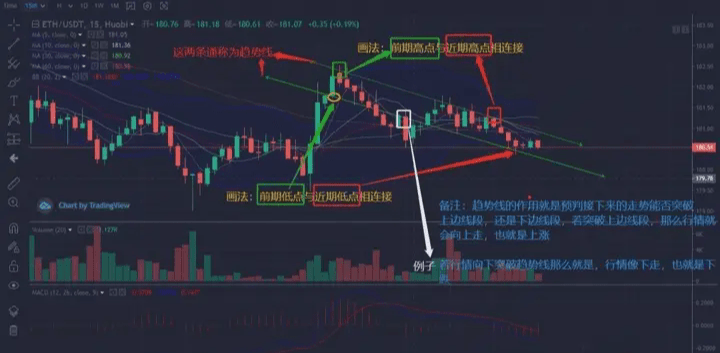
Trend lines are the most commonly used method for analysis.
1. Upward channel trend line (upper segment): Connect the previous high point with the second high point (the recent high point in the current trend) and extend it (as shown in the diagram).
What is a high point?
Simply put, it's like walking from a mountain to a slope, then to a hill, and finally to a plain. At the plain, that mountain represents your previous high point, and the hill you recently passed is your second high point (if you can't understand this, then...).
2. Downward channel trend line (lower segment): Connect the previous point with the second low point (the recent low point in the current trend) and extend it (as shown in the diagram).
After understanding the high point, the low point should be thought of in contrast to the high point.
The role of trend lines: If the candlestick chart breaks through the upward channel, the market will rise; if it breaks through the downward channel, the market will fall.
Third: Judgment of pressure (lines) and support (lines).
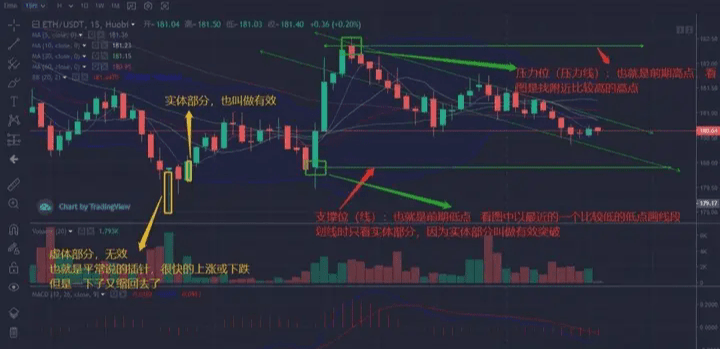
Pressure line drawing method: The previous high point is used as the drawing point, drawn parallel and extended, with examples in the diagram.
Support line drawing method: The previous low point is used as the drawing point, drawn parallel and extended, with examples in the diagram.
Pressure Line: It determines whether the market will continue to rise after reaching a certain position. When placing an order (taking a long position as an example), the pressure level can serve as the maximum profit point for this order, that is, the take-profit point (considering specific situations and positions).
Support Level: It determines whether the market will continue to fall after dropping to a certain position. If it falls effectively, the market will continue to decline. When placing an order (taking a long position as an example), the support level can serve as the stop-loss point for this order. (Consider specific circumstances; specific market conditions and positions have different strategies, and stop-loss and take-profit points vary.)
Let's clarify effective and ineffective breaks. The diagram also has examples. Only when the body of the candlestick effectively breaks can it be considered in judgment. If there is no body break, just a line (commonly known as a pin bar), it is ineffective.
Fourth: The judgment and application of golden crosses and death crosses in the MACD chart.
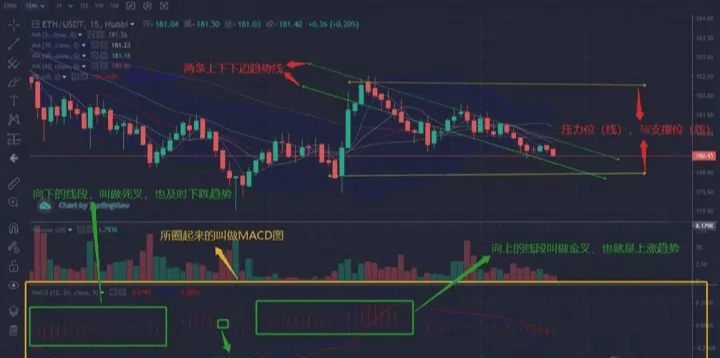
The MACD chart is also used to judge whether the market is in an upward or downward trend.
The yellow area highlighted at the bottom of the diagram is called the MACD chart.
The MACD chart has both golden crosses and death crosses; the upward segment is called a golden cross, indicating an upward trend.
The downward segment is called a death cross, indicating a downward trend.
The length of the segments represents the strength of the upward or downward trend.
Analyze market trends by combining the MACD chart with trend lines.
Fifth: Combined analysis method based on breakout short positions (three-point comparison method).
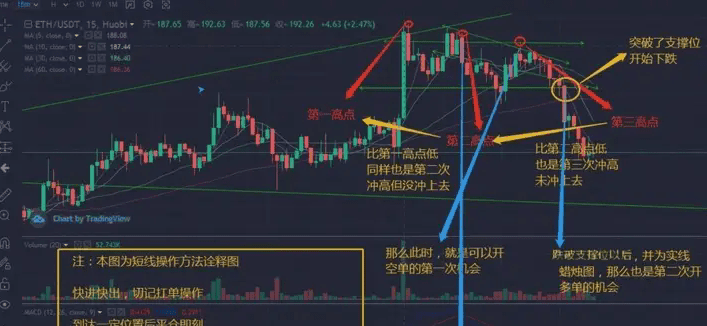
Taking the market situation in the diagram as an example, there are three high points, but each high point is lower than the previous one (the high point is lower than the high point). At this point, we can judge to short based on the trend line and the MACD chart's movement.
Why this understanding? Because every wave of the market does not break the previous pressure level, and each time is lower than the last, we can judge that the overall trend of the market is gradually declining.
When the third high point begins to fall, if it effectively breaks the support level (previous knowledge point), then the market will continue to decline.
Sixth: Conduct grid trading based on Bollinger Bands (quick entry and exit method).
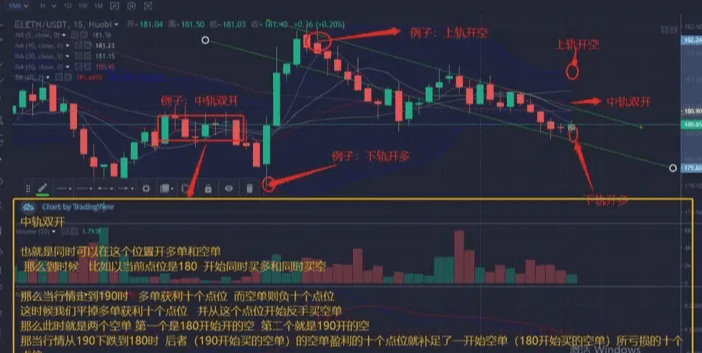
3. Open a long position when the market reaches the lower band of the Bollinger Bands.
Bollinger Bands consist of an upper band, middle band, and lower band.
The principle of this method is: (15-minute, 30-minute lines) 1. Open a short position when the market reaches the upper band of the Bollinger Bands, controlling your position to about one-tenth of your total position, and sell after making a profit.
2. Double opening of the middle band (simultaneously opening long and short positions): Regarding this method, it means that when you double open, regardless of whether the market rises or falls, you have a profitable position. For instance, after opening long from the middle band, if the market reaches the upper band, you can close that long position for profit, then open a short position. Thus, you will have two short positions. When the second short position drops to the middle band, the loss from the first short position (the double-opened short) will be compensated, resulting in overall profit from the long position.
When the market breaks through the upper or lower Bollinger Band, we choose to lock positions, meaning to hedge, by opening a position opposite to the current one, which will control the overall profit and loss of the current market situation, preventing it from increasing or decreasing. Additionally, according to the current upward or downward trend, add another position.
Under the premise that the current market is controlled, another position can be in a profitable state. If the profit point can match the total profit and loss point of the locked position, then a breakeven result has been achieved.
As for the locked positions, if the market retraces or pulls back, then the locked positions can be unwound.
The Bollinger Bands strategy is suitable for breakout operations; remember to control all positions to one-tenth of your total position.
Seventh: Use the '十' symbol to judge market upward movements.
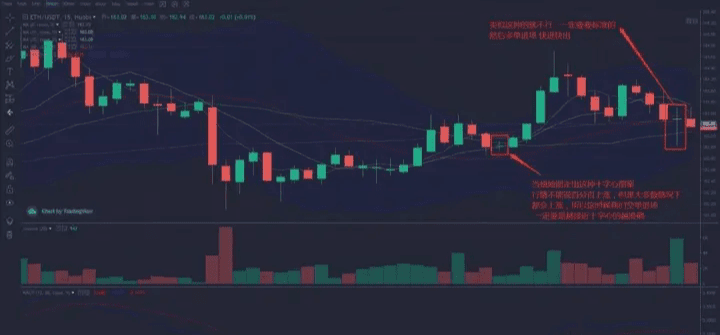
When the market shows a '十' pattern on the 15-minute or 30-minute line, we choose to enter long positions.
Emphasis: This is a rule in the market. Of course, nothing is absolutely certain. The '十' symbol is the same; however, in most cases, when encountering such situations, you can directly enter long positions and make quick entries and exits.
Note: The '十' (cross) symbol must be standard, with equal length and width in all directions, forming a true '十' shape.
After experiencing ups and downs, I have summarized 10 disciplines and insights for trading coins. The content may not be extensive, but it holds great value. If you think it makes no sense after reading it, feel free to say whatever you like!
1. Never chase high prices when buying coins. Always have the mindset that it can rise as much as it wants; treat that coin as if it doesn’t exist.
2. There are only two types of coins; coins bought at the right points are good coins; otherwise, they are trash coins. The best coins are those bought at a large scale, patiently waiting for them to become truly outstanding stocks. This is the right mindset.
3. In fact, the mindset is the most important in trading coins. Many people know it’s not a buying point, yet they can’t resist the urge to trade; this is a mindset issue. If you don’t solve this, any theory is useless.
4. Maintain a stable mindset; do not have feelings for any coin or price level, only look at market signals. Feelings should be reserved for buying and selling points. If your skills are good and you have ample capital, for example, if you can operate on a 30-minute basis, then timing is not a problem.
5. The reasons for mistakes are always unrelated to the market. When looking for reasons, you can only find your own. Any mistake should be summarized immediately.
6. The mentality of rushing to make money is a big taboo for us participants in trading coins. If you can’t control your own heart, cannot control your greed and desires, you cannot succeed in the market long-term. There are two forms of 'short'; when you hold coins, your thinking is controlled by the bulls; conversely, you are a slave to the bears. Market emotions accumulate and are guided by this. Those who cannot escape this state will forever remain false market participants.
7. Trading coins tests long-term profitability, not one-time explosive abilities. The key is a long-term effective trading strategy. When buying, you need to consider various situations, hold firmly, and sell decisively to gradually improve. You are trading coins, not the coins trading you; start with yourself.
8. The virtual currency market will only reward those who are patient. Any good coin needs to be nurtured. Constantly switching to new coins will surely lead to small capital and small gains. Focus more; running around every day will not yield big profits.
9. Dance with the rhythm of the market; as long as you follow the market rhythm, you can navigate smoothly on the edge of a knife. Rhythm is always the market's rhythm. A market participant without a sense of rhythm will always suffer. Let go of your greed and fear, and listen to the market's rhythm. As long as you can act according to the rhythm, no one can stop you. The market has a rhythm; grasp the current rhythm, and no one can defeat you.
10. When playing with capital, remember that the power of compound interest is the greatest. As long as you have a good mindset and skills, compound interest is inevitable, which can overcome everything.
Meeting is fate, knowing is destiny. I firmly believe that those destined to meet will eventually recognize each other from a distance, while those who miss each other are destined. The journey of investment is long; temporary gains and losses are just the tip of the iceberg. It’s important to know that even the wisest will have their oversights, while the foolish may achieve unexpected gains. Regardless of emotions, time will not stop for you. Pick up the burdens in your heart and stand up to move forward.
Teaching a person to fish is better than giving them fish. Whether investors are beginners or experts, what I offer is not just financial returns, but also growth in investment knowledge and experience. Throughout my investment journey, I will provide investors with market analysis ideas, basic knowledge of trading, methods for using various investment tools, as well as insights into fundamental analysis, clarifying chaotic international situations, and identifying various investment influences. Allowing you to become both a winner and an expert in investments!


